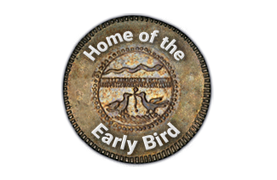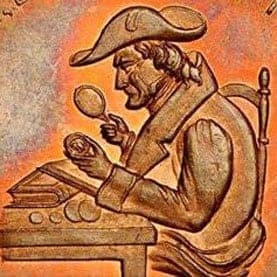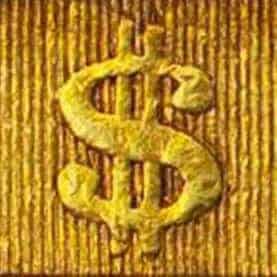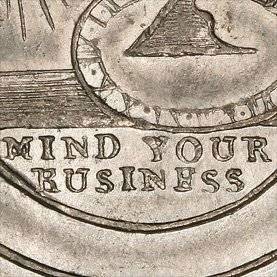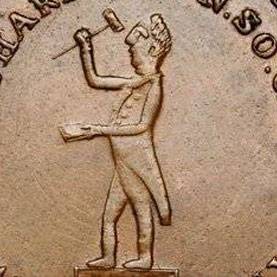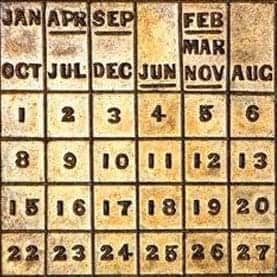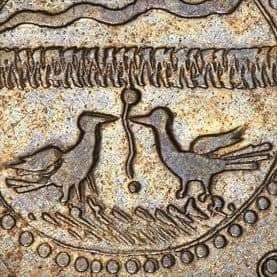November 13-17, 2012: The Whitman Baltimore Expo
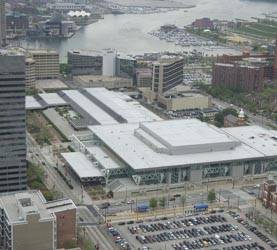
November 13th: Prologue
No one likes a good coin show more than your author, but I have to say I am looking at this one with perhaps just a little trepidation only because I fully expect to be completely, totally and thoroughly exhausted (even more so than usual at one of these events) by the end of it.
Let’s examine why:
First, I’m typing this at 2:45 AM on a Tuesday, a biproduct of catching the first flight down in the AM. So I’m already tired and the thing hasn’t even started yet.
Second, the handle on my suitcase is balky, making it very hard to roll and very likely that I am going to end up carrying the damn thing at some point during this trip (quite possibly as soon as this AM when I get to the airport).
Third, this show was a zoo (in a good way) even when we used to have team Agre & Wnuck working the table – so it might be a real handful with only your author.
Fourth, I have a huge pile of grading I need to get done while I’m down there.
Fifth, because this event is being held for the first time in conjunction with the C4 (Colonial Coin Collectors Club) Convention, it will be even more crowded and possibly busier at CRO then usual.
Sixth, the aforementioned C4 guys have a reception on Thursday evening during which I usually celebrate by getting plastered and staying out real late (and I’m not the only one).
Seventh, Stack’s-Bowers is holding some mega-auctions, which will necessitate your author lot viewing like crazy (even though I already viewed some in NY last week) before or after show hours whenever possible.
Eighth, the enormo-colonial auction (among the biggest ever) will be held on Friday evening starting at 6 PM and undoubtedly running until the wee hours (like 2 AM, maybe).
Ninth, anyone who doesn’t win what they want in that sale is likely to hit the bourse on Saturday AM with a full head of steam looking to buy something, so I will need to be at the table first thing that morning.
Tenth, I’m pretty sure you get the idea.
On the other hand, I can’t think of anything else I’d rather be doing.
And to prove it, I’ll be Road Reporting from Baltimore every day this week, so if you can’t be there in person, stop by here every morning and I will try to give you the full flavor of what’s happening on the ground at this show.
November 13th: Day 1
To all of you who predicted that the sliding handle on my suitcase would freeze in the ‘down’ position the moment I arrived at the airport in Boston forcing me to carry it to the ticketing counter like in the olden days before wheeled luggage: Congratulations. You were correct.
I was, however, un-slowed down by this experience, landing in Baltimore, again carrying the bag to the taxi stand and arriving at my inner harbor hotel at about 8:30, chucking everything in the room and making a bee line for Stack’s-Bowers lot viewing at the convention center.
Just one minor problem though: There was some pretty intense security on Tuesday for something called the Jewish Federation of North America’s General Assembly, which seemed to be an extremely well-attended affair occupying most of the 3rd floor.
Which meant that all would-be lot viewers (like your author, for example) were given the once-over and then asked to put on a blue ID bracelet of the exact type you receive during a hospital visit before continuing on to Room 307.
Even so, I still got there early, and ended up cooling my heels with another 10 people waiting for the doors to open.
When they finally let us all in, I found a seat, and then proceeded to go through the entire sale (for the 2nd time) in sequence, never having to wait for a box or being told that “that white haired guy over there has had Box #14 for 45 minutes, so you are going to have to skip ahead”. Frankly, that was amazing, since by then the viewing room was SRO. I guess I just got ahead of the curve, and stayed there.
And, as is often the case when I view things more than once, I liked a few coins better the 2nd time, and a couple others less, but ultimately accomplished my goal of figuring out exactly what to bid on, and how much. I also got to chat with a lot of collector and dealer friends who all seemed to be pretty up-beat, possibly because they were looking at coins all day when other people around the country were working.
I did not however provide any useful info to the people who wanted to know my opinion of lot #1266, for example, or how much I thought the American Beaver Medal would bring. That does not seem to dissuade people from continuing to ask me though.
And then, after 9 continuous hours of viewing interrupted only by a brief lunch break, a few phone calls and the aforementioned questions, I was done, packed up, walked back to the hotel and then tried extremely hard to stay awake until dinner with a dealer friend at the Diamond Tavern for a meal notable for its delicious grits, and for the fact that our waiter shook hands with us twice during the meal. I don’t know why.
Then I headed back to turn in early so that I would be ready for auction session #1 which begins, amazingly, at 10 AM on Wednesday.
More later.
November 14th: Day 2
It was a reasonably productive Wednesday during which I got a lot done, and had the pleasure of walking up and down Pratt Street (on which the convention center and a lot of the hotels are located here in the inner harbor) in uncomfortable shoes, repeatedly.
The first trip being from my hotel to the Stack’s-Bowers auction, session #1, where I sat in on a few hundred lots of medals, tokens and knick-knacks (which I do not mean pejoratively) and unfortunately watched most of my handful of widely space but seemingly aggressive bids (since I was semi-interested in only a few of these pieces) get skunked by the same guy.
After which I strolled out into the lobby just in time to get my shiny new show badge, do some actual numismatic business with some dealer friends, drop my show supplies off at the security room and then head over to the Sheraton to submit some extra-early grading to PCGS in hopes of getting them back in time to offer at this show.
Then back up the street to the Hilton to check out the wholesale activity which by then was quietly raging in some 2nd floor conference rooms. And though I did not rage as much as some of the other guys, I did OK, including picking up a few coins that I then needed to take back to PCGS again at the Sheraton on the opposite side of the extremely wide convention center, where the security was not as tight as Tuesday, but people kept asking me who I was and where I was going anyway.
By the time I finished that, it was about 3 PM, just in time to walk all the way back to my hotel, figure bids like crazy for the 6 PM Stack’s-Bowers federal session, and the Friday evening colonial session, and eat an extremely late lunch.
Which would be interrupted (in a good way) by a call from a good customer friend who had arrived in town and wanted to have dinner. I had planned to attend the auction live, but decided to enter my bids on the computer, and then walk back to the Sheraton via the convention center, again, answer the prying questions from several different members of the security staff, again, and make my way to Morton’s where I believe every other table was filled with numismatic types.
After which we walked back up Pratt Street, which at that time of night doesn’t seem like a great idea, since you tend to run into aggressive pan-handlers (check), and people who look like they might want to mug you (check) and/or ask you directions to places you’ve never heard of (check).
I am pleased to report that I did eventually arrive back at my hotel safely and just in time to follow my last few auction lots on the S-B site, win one and chase a second one into low earth orbit before finally letting the other guy have it at a price that was sufficiently high that I should have been relieved not to win it, but wasn’t.
And then spent the next 2 hours working on colonial bids, world coins bids and verifying Thursday’s schedule, which will start early with dealer set-up at 8 AM, and continue late into the evening at the C4 reception and include the world auction, another federal auction session and a lot of business on the bourse floor to fill in every second in-between.
All of which I will try very hard to describe right here on Friday AM.
November 15th: Day 3
All that walking on Wednesday paid some dividends early, as I was ready to go when the show opened to dealers promptly at 8 AM on Thursday.
First order of business (and one of the biggest challenges of going solo at these shows): Get the table set-up and all the coins in the display cases as fast as possible so I could walk around and check out other dealer NEWPs. Fortunately I sort of have this thing down to a science now, and was able to get up and running in about 10 minutes or so with only one (1) minor lamp mishap in which I was gently stabbed in the hand with a shard of broken light bulb.
Fortunately, I recovered from that just in time to race around the floor visiting my good contacts and buying their best stuff before someone else did. Which on this first foray amounted to an OK total of about 30K worth of world and federal issues, but all very choice and most with an extra bell or whistle or two (cool color, nice crust, old holder, gold sticker, etc.). I pondered a few other great colonials that I really liked, but just didn’t think I could make any money at the prices being asked (which is sort of an important consideration in this or most any business).
After which I returned to the table where I would park myself for most of the next, oh, 8 hours or so seeing old friends, meeting new customers, selling, buying neat things that walked up, working out a couple of trades, taking a couple of cool coins on consignment and doing what I would describe as a typical Baltimore Thursday level of business and generating a not-unimpressive pile of invoices neatly stacked and collated in the back case. Which was a far cry from the old days when Dave and I would just fling all the paperwork on the back table in a filing system known as the “we’ll just sort all this out later” method.
I was able to steal away for a few minutes here and there during the course of the afternoon to pick up my first waves of grading (which, so far, seemed just fine), visit a few tables occupied by dealers who were not set up the first time I walked around early in the AM, check out the Stack’s-Bowers highlights from the January Americana auction, and, most importantly, view some Houston lots at the Heritage table (since it likely makes my planned trip down there to view and bid in person unnecessary).
So I was feeling pretty darn productive back at the table again for the home stretch, which proved to be extremely busy and included some good federal sales to a several different buyers.
And then like a shot I was off to the C4 (Colonial Coin Collectors Club) reception at the Sheraton at 6 PM, during which all of the usual suspects ate, drank and talked about colonials for hours, continuing on after I had to leave to go back to my hotel to finish the CRO ad due tomorrow, and work on bids for Friday, a process which took waaaay longer than I expected and had me up a lot later than I wanted.
But that was too important not to finish, since I expect tomorrow to be absolutely crazy during the day and capped off by an auction that might, quite literally, run all frickin’ night.
So if tomorrow’s installment of the RR is late, you will know why.
EOM
November 16th: Day 4
Good morning Road Report reader, and welcome to the Day 4 installment of our 2012 Fall Baltimore Expo story. And this one might not be our best effort ever, since (as was well-documented on this site yesterday) I got back from the auction in the middle of the night (2:20 AM, to be exact), and I am now typing this, sharp as a tack, on about 3 very average quality hours of sleep.
But our story of Day 4 begins a bit more than 24 hours ago, with your author finishing up the exhausting Stack’s-Bowers online bidding process at the hotel, and then heading off to the convention center at what was for me a veeeeery late 9:15 AM start. On the way I passed many other dealers, though, indicating that maybe this is simply when every one else usually shows up.
And once there, it was busy right from the outset, with sales across the board of new items (including a truly wild Cinci commem purchased mere hours earlier) and old friends in all categories (including that cool $20 in the PCGS Regency holder which I am surprised remained on the site as long as it did). In total, most of the activity was in the low to mid 4-figure range, but some of the expensive stuff is now also “in play”.
I bought very well too I believe, with a neat stack of fresh colonials (even though I knew I would be buying many, many more at the auction later), and a variety of federal copper and silver coins from all different sources which I will be variously grading, CACing, photographing and uploading as fast as I can (with fast being a relative term, since that all takes weeks as you may know).
I also got back some deluxe grading, including some significant federal issues and one box of mid-grade colonial coins that came back pretty much but not exactly as I expected.
Oh yes, somewhere in there I also ate a yogurt.
And then, at about 5 PM, just after selling two of our deluxe English copper coins, I locked up the table, headed back to my hotel for some last minute prep and walked back for the start of the 6 PM Stack’s-Bowers Early American Coin Session / endurance test and settled in for what everyone knew would be a long (possibly the longest) night.
And it was a fascinating and much anticipated session which included some superb condition pieces, seldom seen rarities, lovely collector grade colonial type coins, off-quality hoo-ha, obscure die varieties and highly esoteric pieces, slabbed and raw, all offered in a marathon 900+ lot sale conducted in what meteorologists call a “derecho” (i.e. one straight shot) over a period of 9+ hours from early evening to early morning.
Interestingly, these pieces were auctioned in what catalog afficionados refer to as “1970’s Bowers and Ruddy Style” (i.e. arranged by consignor, as opposed to by coin type), and thus challenged would-be bidders interested in St. Patricks coinage for example, to orienteer their way through the catalog and find the three different places where they were being sold (hey, no one said it would be easy).
And our story begins, as is customary in these recaps, with the beginning, including 113 lots from the Jack Royse Collection. Mr. Royse was a colonial type collector active starting in the late 1960’s until his last acquisition in 2006, acquired his coins from a variety of well-chosen sources, stepped to the plate on occasion to buy something rare and expensive and, based on the ravenous results here, selected things that other people liked, too.
Such as lot #6002, an extremely rare New England Sixpence which was discovered by some lady with a metal detector in a potato field on Long Island in 1990, last traded at Sotheby’s in 1991 for $35,200 (the last time any example of this denomination traded, in fact) and here brought $431,500 in spirited bidding despite a strong gash across the obverse likely inflicted when it was dug up (this and all other images courtesy of Stack’s-Bowers):
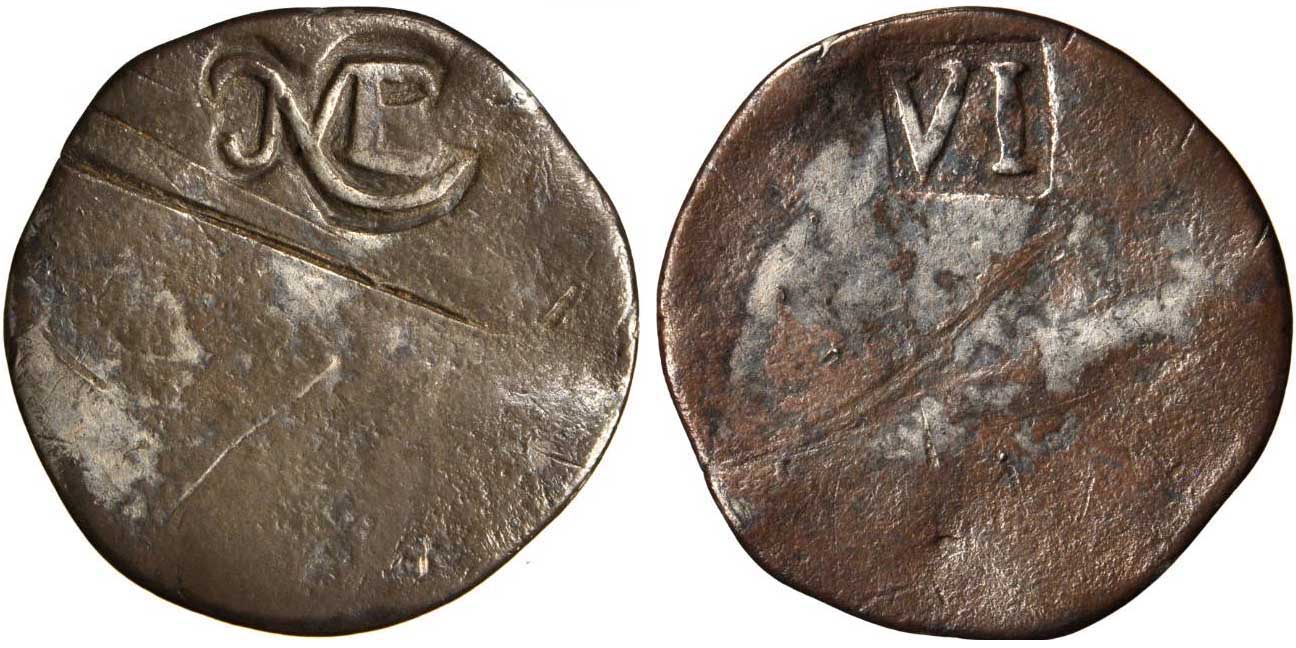
Followed soon after by lot #6022, an admittedly nice 1783 Nova Constelatio, Blunt Rays in PCGS XF40 holder and one of a number of lovely, original type pieces in this offering, which sold for what had to be a new record price for this issue in this grade of $2,875, since high AU coins have sold for less in recent months:
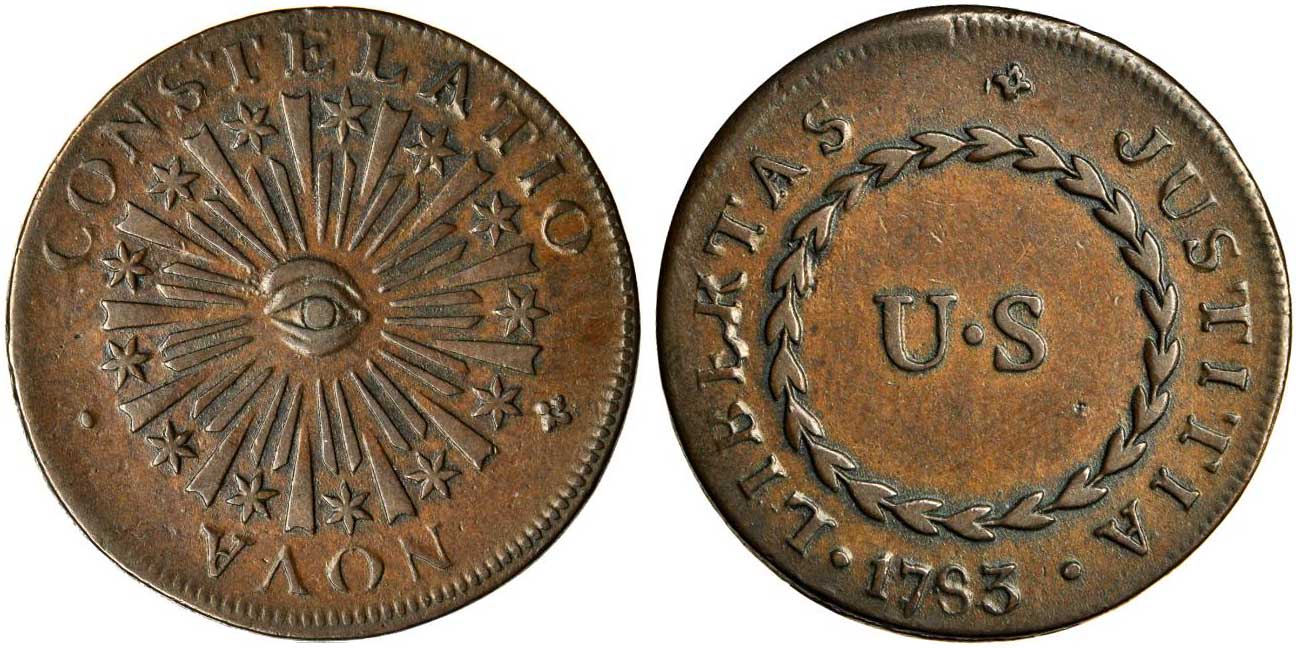
But not everything was highfalutin, such as lot #6047, a common 1787 Connecticut Mailed Bust Left with uniformly rough gray-brown surfaces and some pronounced planchet flaws / cracks that brought $230:
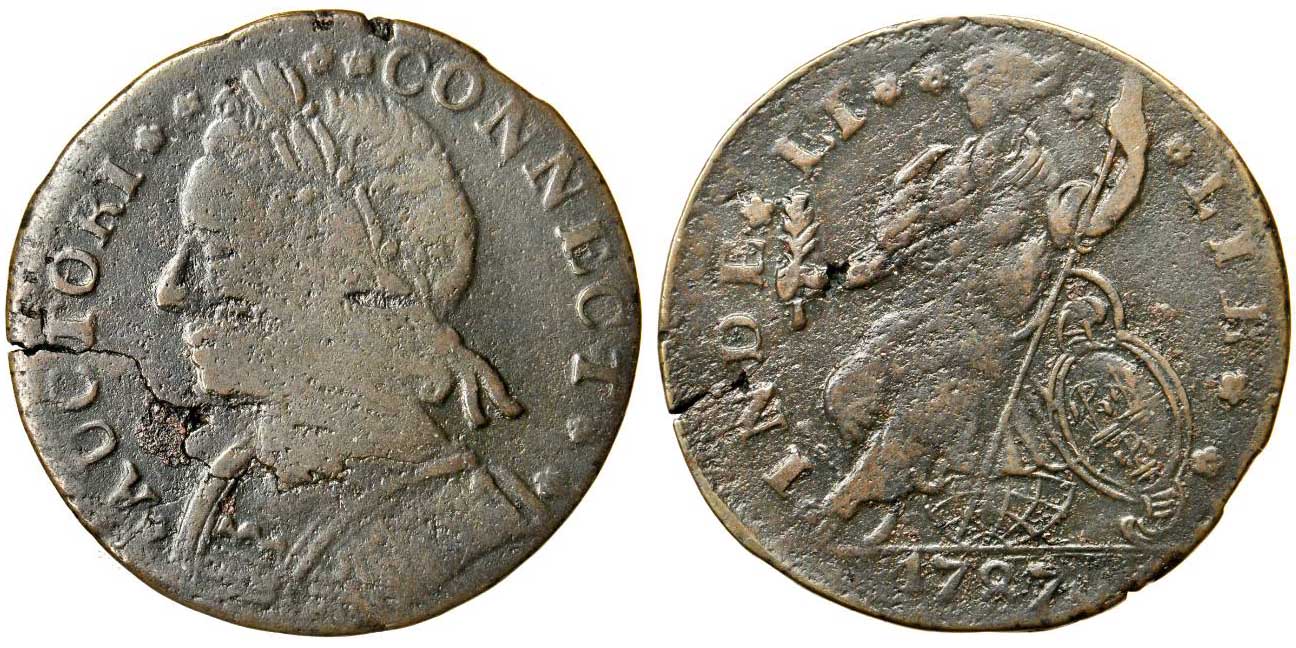
Which would be but a temporary lull preceding lot #6056, the R-7 George Clinton Cent in appealingly smooth golden brown Fine condition and pedigreed to the 1983 Roper Collection:
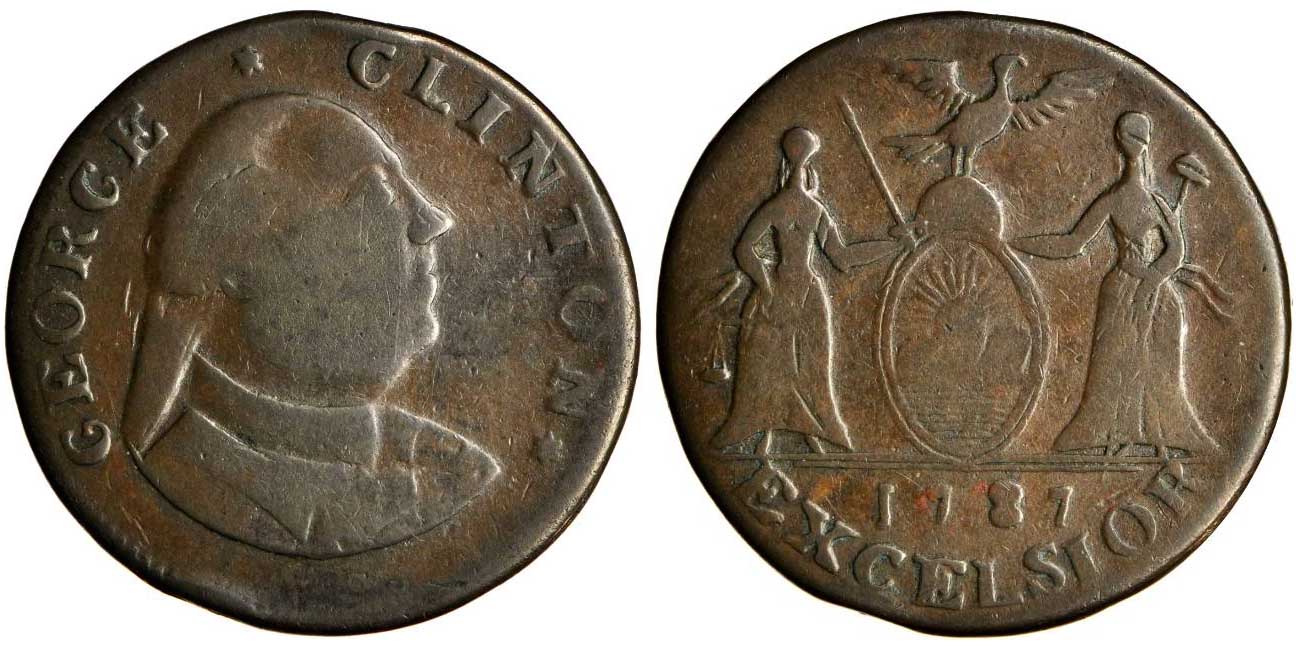
And this was entertaining for me, since it was the first one I have ever personally seen being auctioned. Pre-sale estimates ranged from low 6-figures to an extreeeemely optimistic “3 to 400 thousand” prognosticated by a C4 member earlier that day, with the actual result somewhere in the middle at $218,500. Time to update the Redbook, I guess, since the $25,000 value in Fine now seems sliiiiightly outdated.
And eventually we were on to the long-off-the-market offering of pieces from the Ted Craig Estate. Mr. Craig passed away some 4 decades ago, and these coins had been unseen, and in many cases unknown, since then, starting with one of the longest runs of St. Patrick’s coinage ever offered for sale. Including lot #6115, the nicest farthing of the group looking especially bold in a PCGS AU50 holder and bringing what I thought was a pretty fair $14,950:
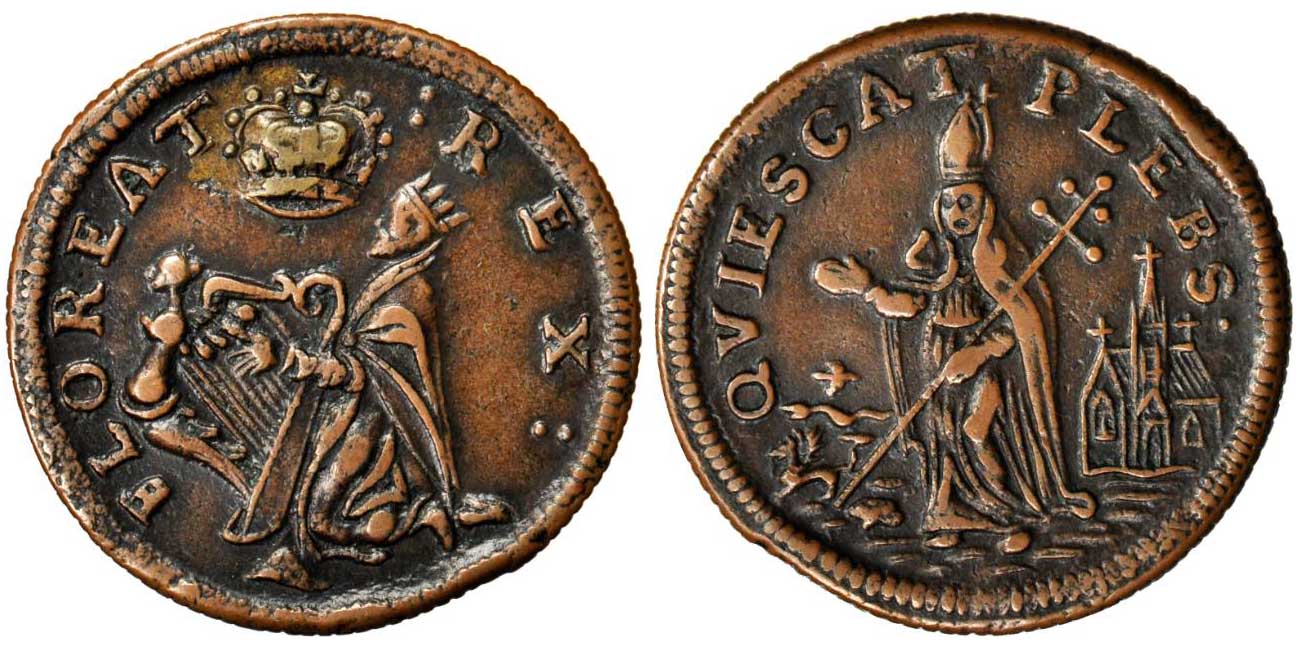
Followed by a lot of high prices on smooth golden brown pieces, and low prices on rough / dark examples with an occasional exception when a die variety specialist would step to the plate. Which is what I assume (hope, pray) is what happened on lot #6120, a dark, rough piece with scratches that bought $9,775:
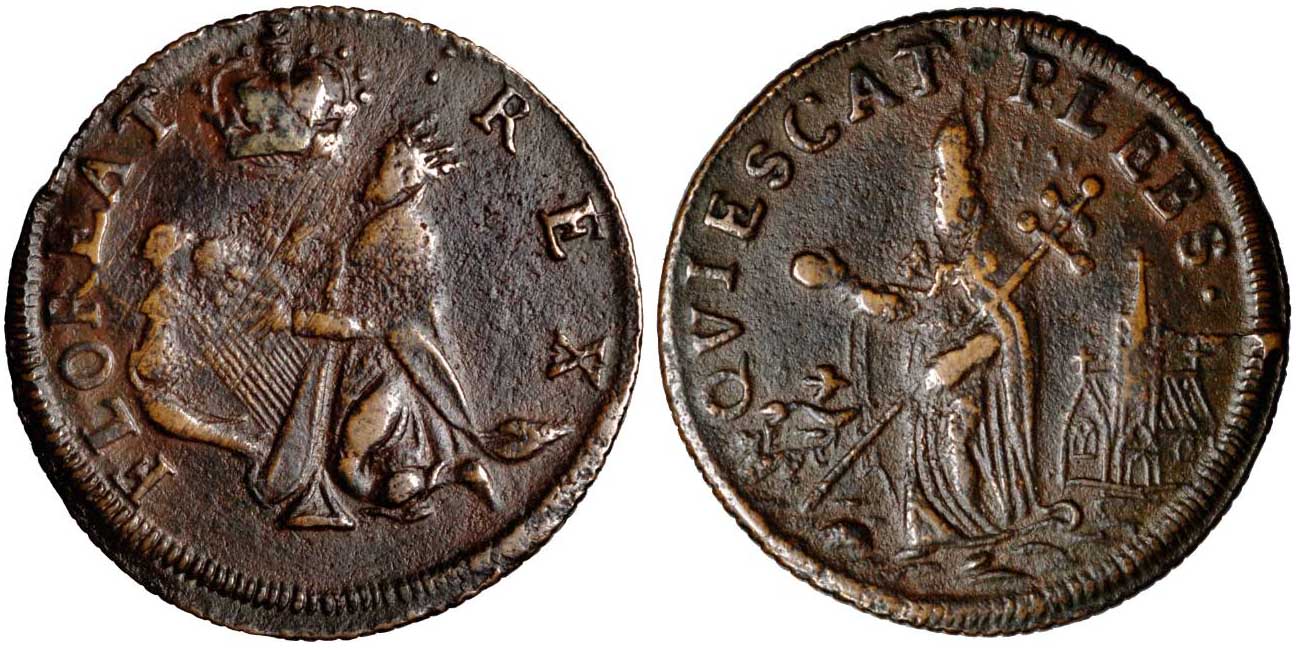
Which would pale in comparison to lot #6148, the nicest silver St. Pats to come to market in, oh, ever, in what I thought was a conservative PCGS AU58+ holder selling for $80,500 to your extremely happy author:
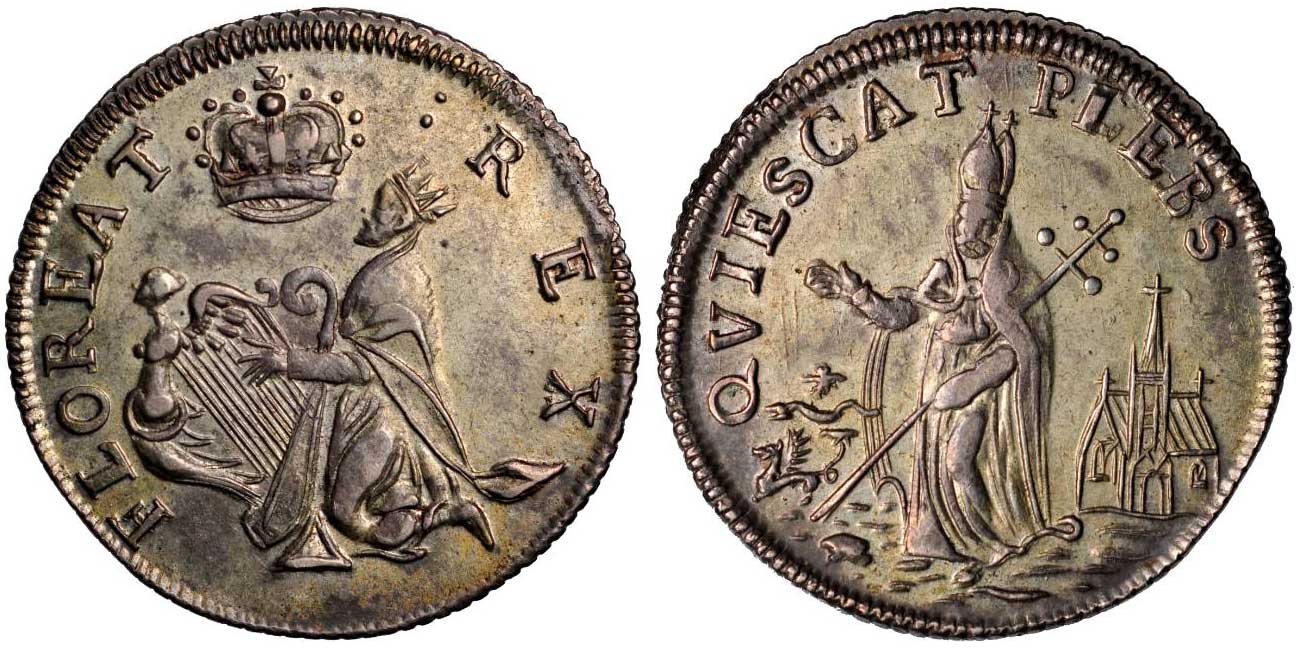
And while I thought that was good money, it didn’t seem like quite so much a few minutes later when lot #6207, the apparently unique but environmentally challenged American Plantation Token, Newman 7-F variety, hammered down for $86,250 in a spirited battle between an irresistible-force-floor-bidder and immovable-object-book-bid:
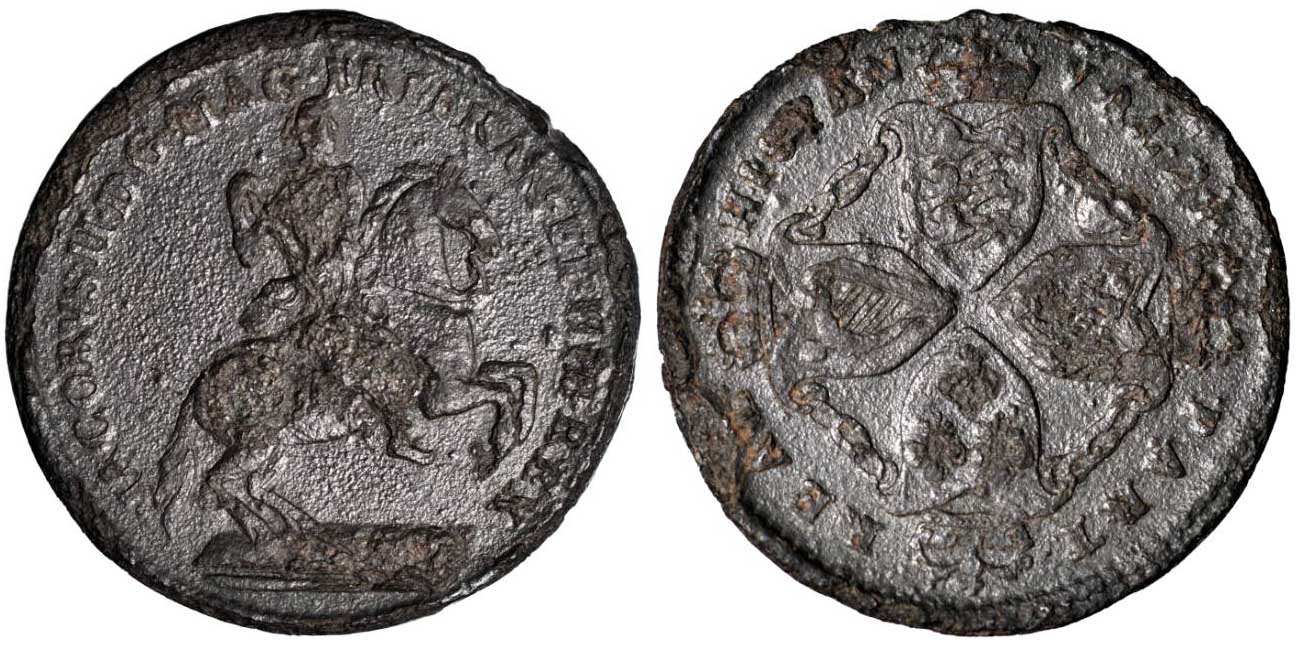
From now on, I will spend more time varietizing my American Plantation Tokens, that’s for sure (Editor’s note: The selling price of this item was later reduced to $35,250 in a post sale adjustment).
Bringing us to what was to me one of the more interesting results / educational opportunities in this sale when these two examples of 1760 Voce Populi Halfpenny, Nelson-2 variety, lot #6212 and #6213 respectively, came to the block:
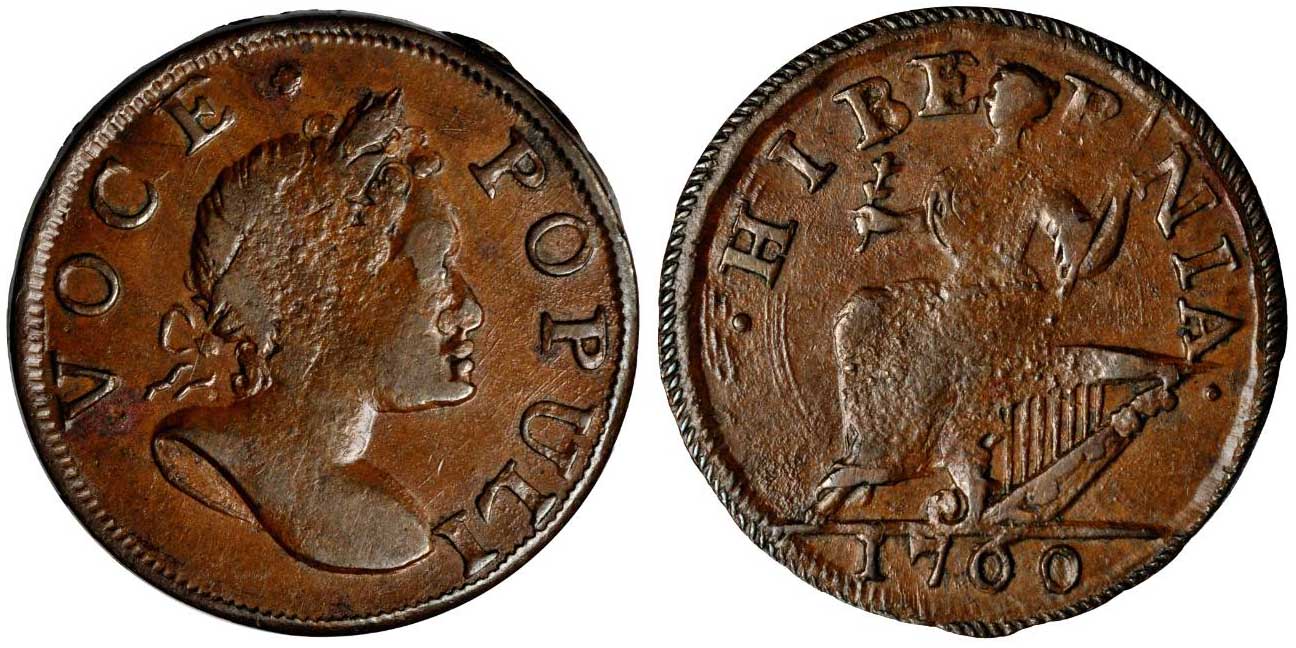
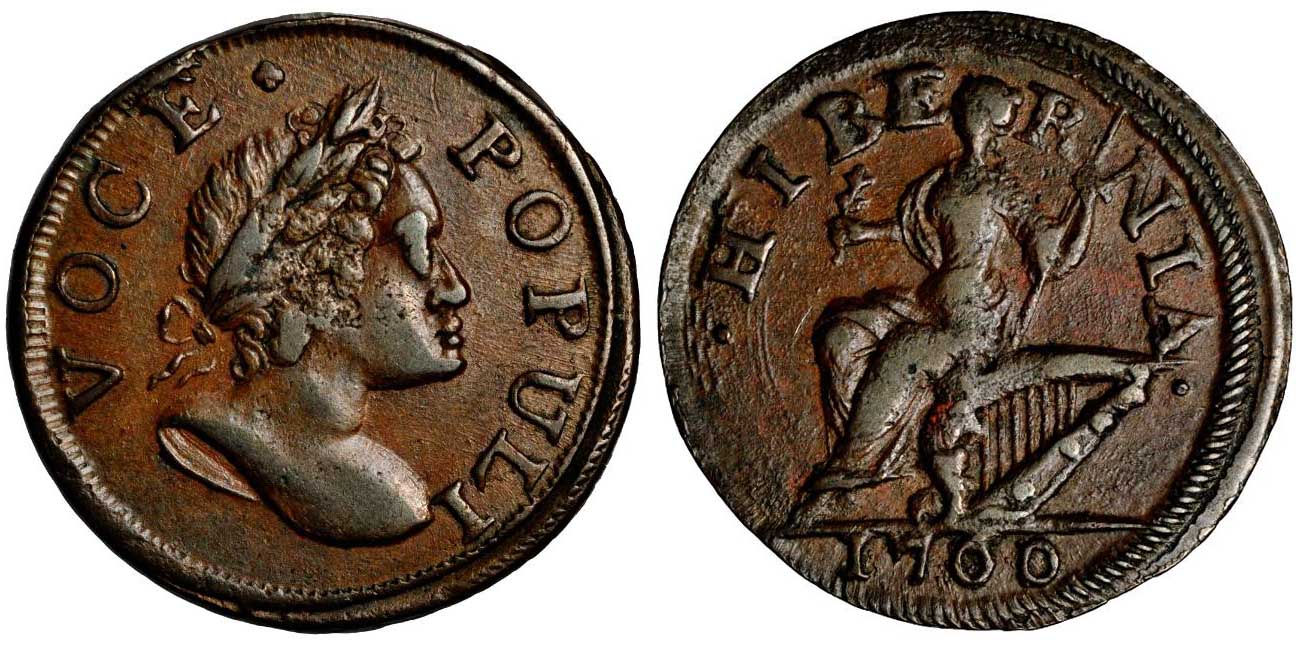
In terms of technical grade I (and the cataloger) considered both coins to be AU, and both had nice golden brown color and pretty choice surfaces for the issue. But of course in colonials, grade, color and surface quality are only part of the story, since the unusually bold strike (for this issue) evidenced by the second piece carried it to a price realized 9x higher than the typically struck first coin at $632.50 vs $5,750. Gulp.
Next we were on to Mr. Craig’s long run of 1721 and 1722 French Colonies 9 Deniers, an underappreciated issue that just about never comes nice, apparently because Mr. Craig had hoarded a big pile of the good ones. Even so, I was personally astounded by some of the prices realized. Such as lot #6245, a scarce 1721-B example with the best color I’ve ever seen on one of these, but with a weak strike and housed in a modest PCGS VF20 holder that did not prevent it from bringing a new record for this type by a factor of about 3x at $23,000:
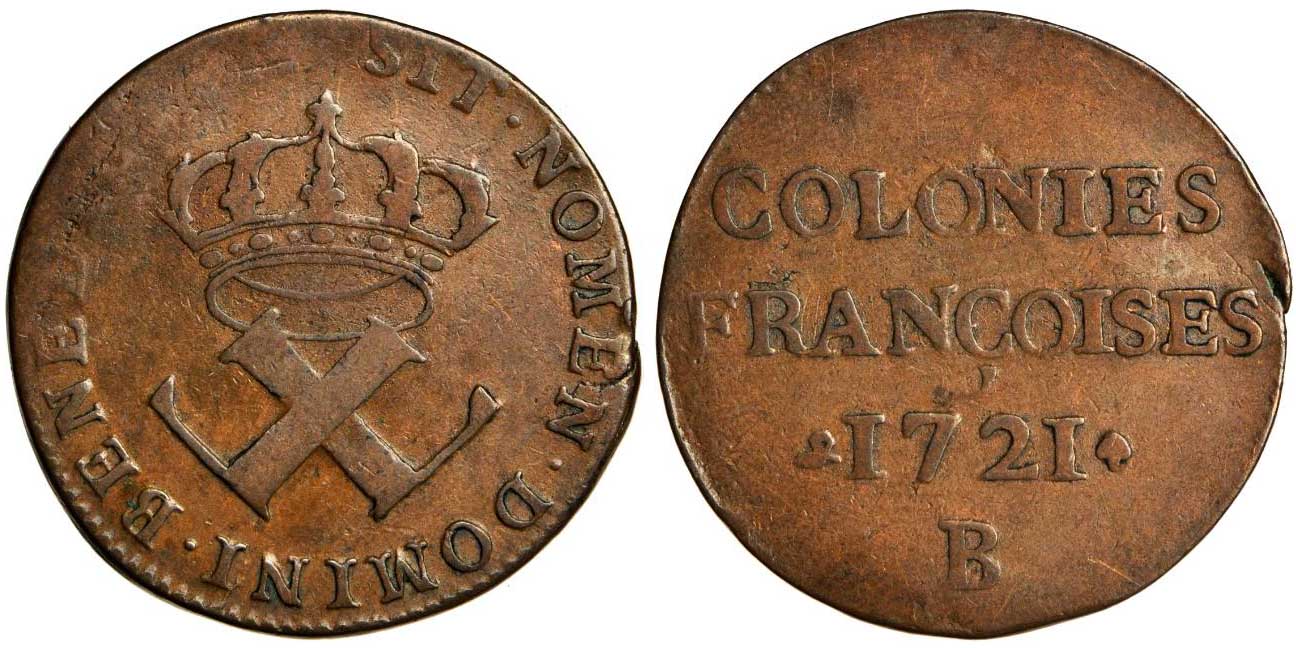
And so it went for most of the examples in this session, variously eclipsing or downright stomping on previous prices realized to type buyers and die variety specialists alike.
With our next highlight being lot #6299, a 1788 Machin’s Mills Halfpenny, Vlack 13-88CT variety in superb Choice AU (for an issue that usually looks really awful) which brought a highly justifiable $16,450 to someone other than me:
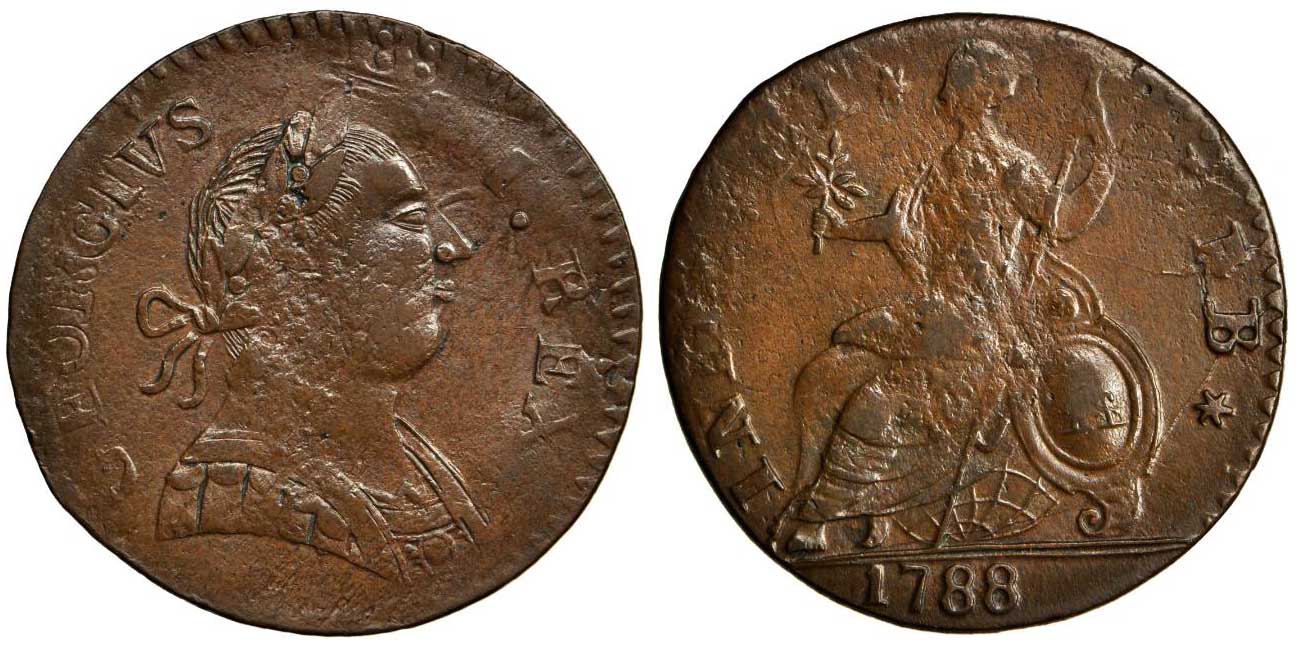
And then began a long run of Massachusetts silver coins apparently from myriad consignors, of mixed quality, reserved and not, problem free and problem full, but most generating enthusiastic bidding to a packed house. Including lot #6037, a pleasing Oak Tree Threepence in a PCGS XF40 holder that brought $17,250 all-in:
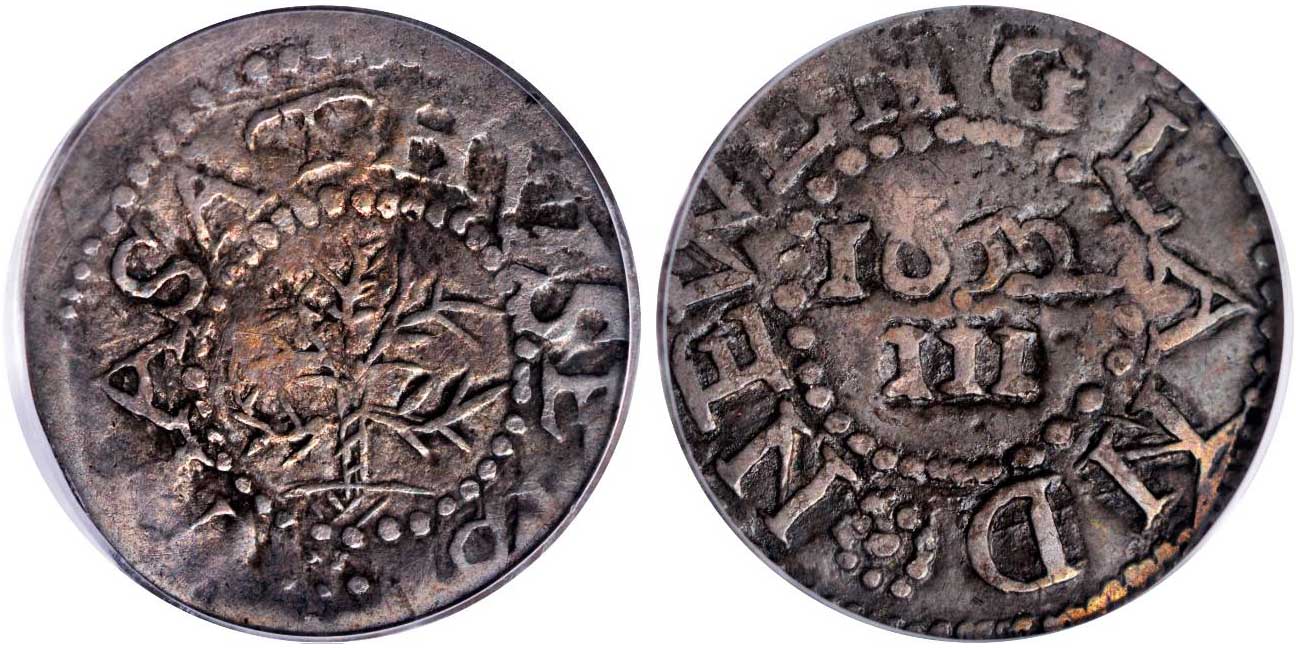
For those scoring at home, that is a nice increase to the $9,200 this same coin brought in the Ford sale in 2005.
And then the interesting pair of 1652 Pine Tree Shillings, Noe-10 variety in lot #6331 and #6332 respectively:
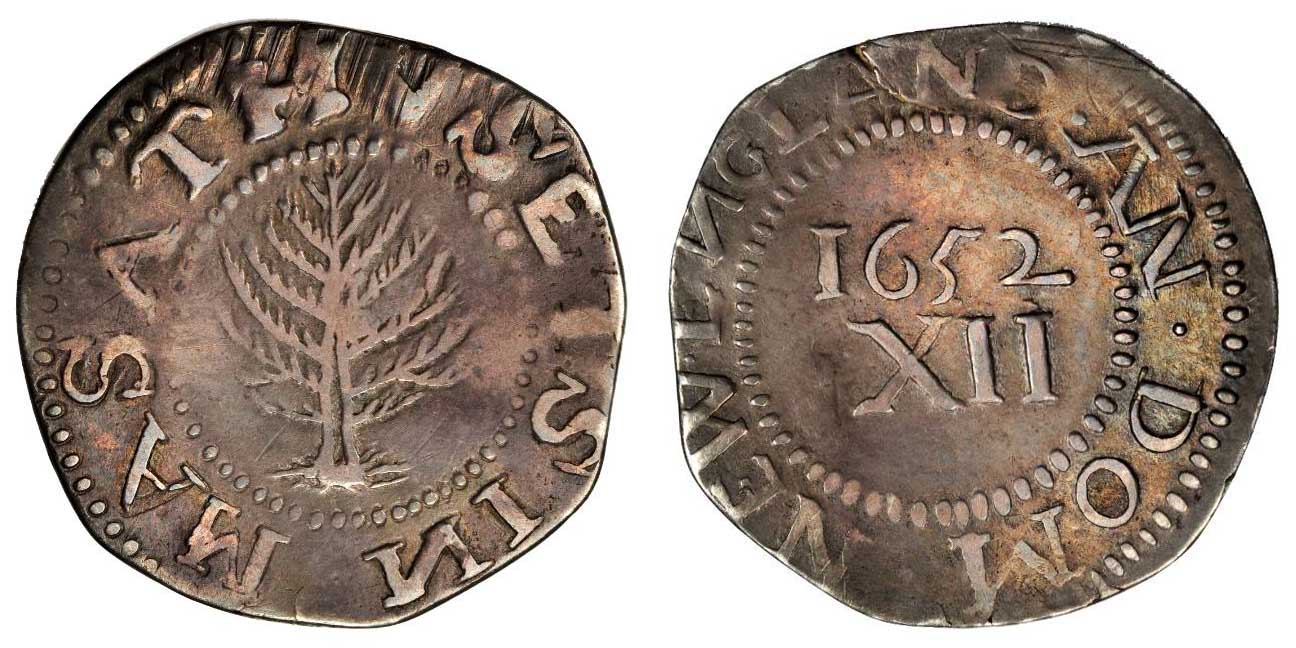
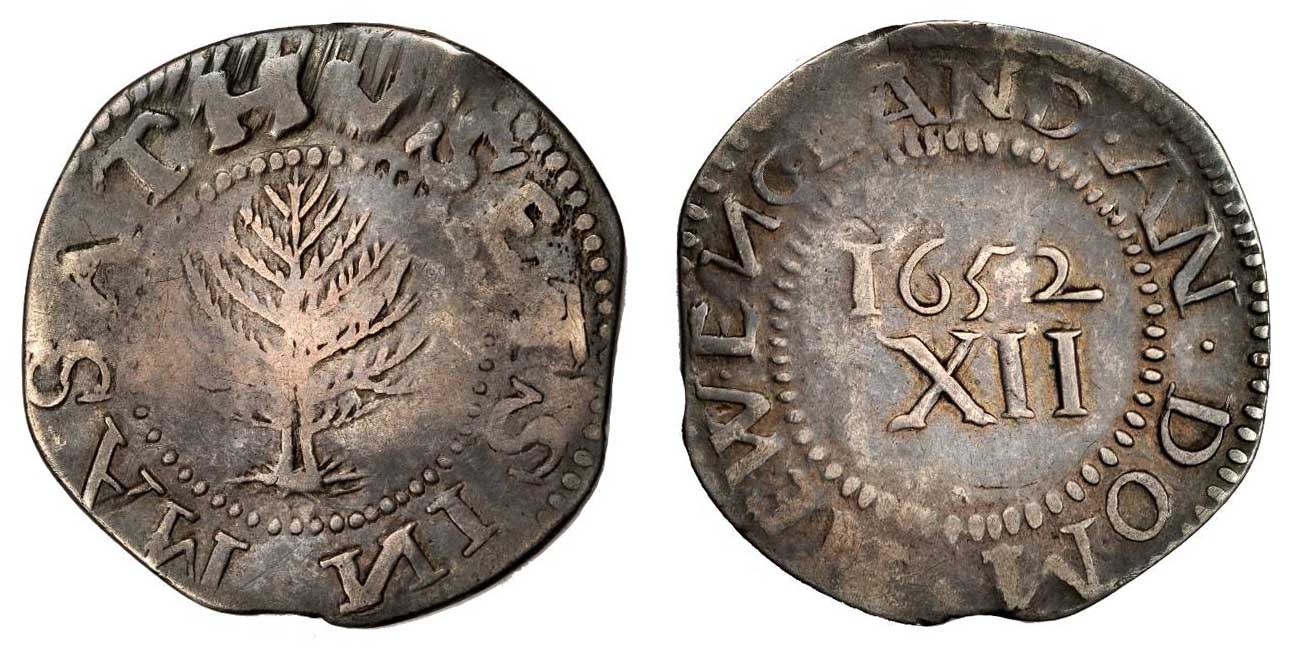
Despite the fact that the first one was higher grade (PCGS VF35 vs VF25), and looked higher grade, it sold for less. Which I chalk up the inefficiency of the auction process.
Then we were on to an assortment of colonial type of decidedly mixed quality, from the choice and high grade like lot #6411, a PCGS MS63 Rhode Island Ship Token which brought $11,456:
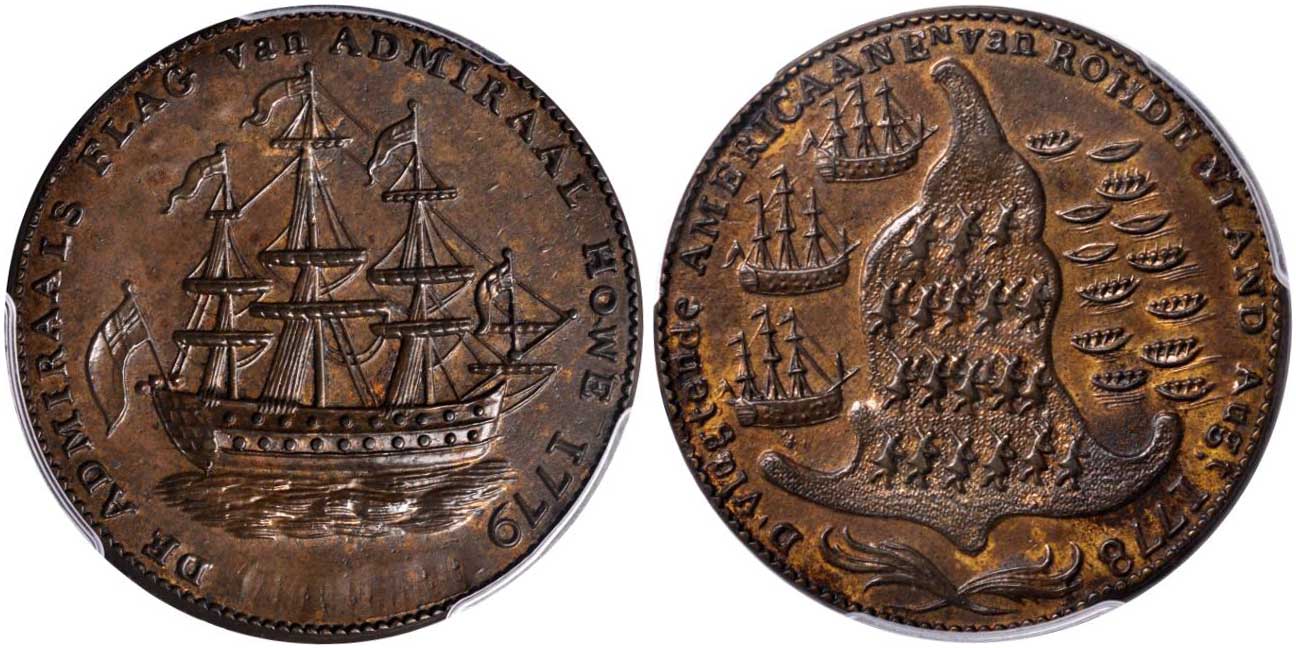
To the well worn and less choice, like lot #6479, a 1787 Connecticut Mailed Bust Left, Miller 11-E variety (one of 13 of these in this session) which hammered for what I honestly thought was a super strong price for that coin at $65:
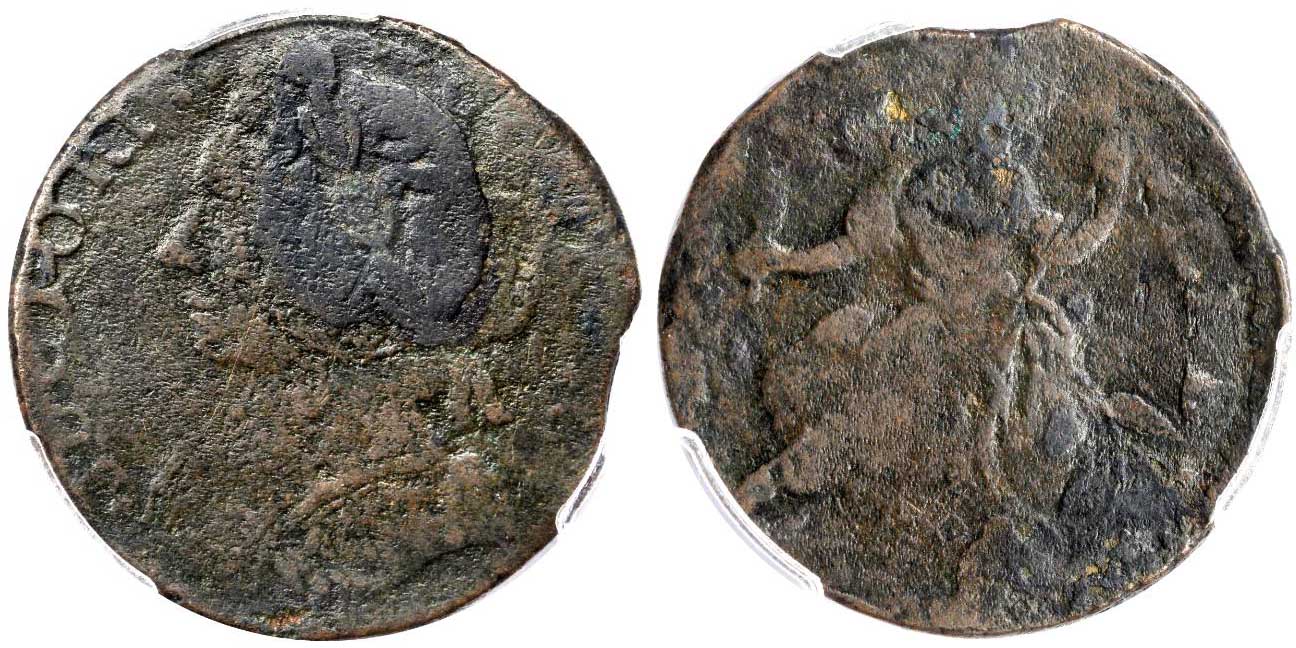
And then we were on to the Vermonts, including coins from Dan Friedus (of Higley research fame) and other consignors which was significant in terms of die varieties represented, sharpness (with a number of well detailed examples), and provenance (with coins traced to an august list of famous owners and sales, including John G. Mills, George Earle, Matthew Stickney, Hillyer Ryder, Richard Picker, Herbert Oechsner, Robert Hinkley and the famous 1975 Pine Tree EAC sale to name more than a few), but many with graffiti or damage and most lacking the choice surfaces most sought after in today’s market.
Such as lot #6645, this 1787 Vermont Bust Right Ryder-14 ex-Mills with lovely color but with some sharp graffiti or tooling on the obverse and reverse which held it down to $499:
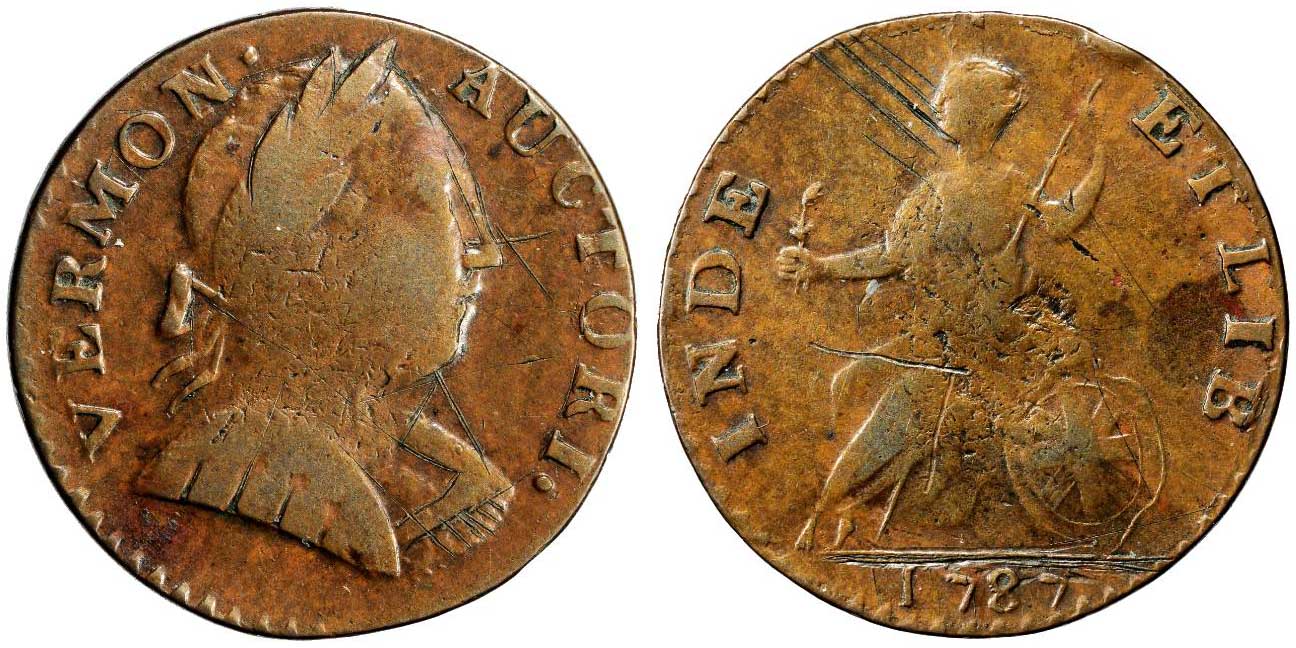
And lot #6686, a 1788 Vermont Ryder-27 ex-Stickney with lovely color and excellent detail, but some big, intentionally inflicted X’s scratched across the obverse and reverse, which realized $1,116 while your author sat on his hands:
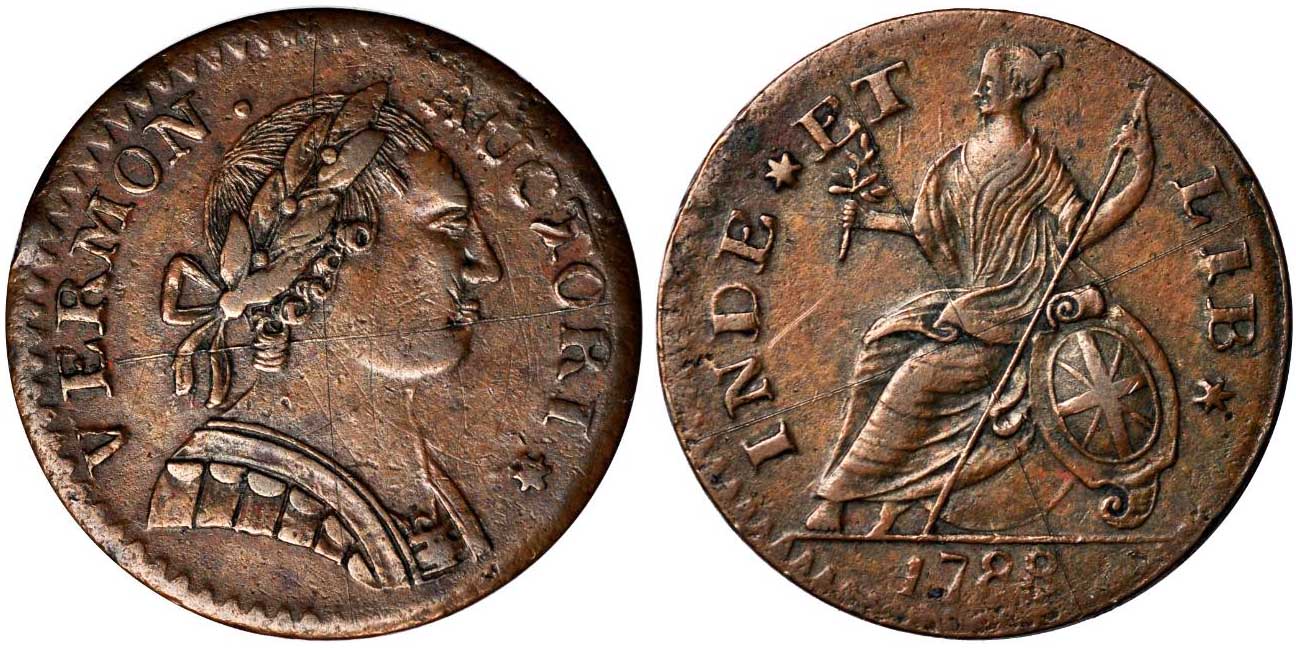
As the Vermonts were selling I was sitting there starting to wonder if the low prices some of them were bringing could possibly be even less than the consignor had paid for these coins 20 – 30 years ago, a theory I later confirmed to be true on at least a few. I personally believe that to be food for thought.
But while the Vermonts were a little rough around the edges, the Rob Retz Collection of Fugios (which would be next) were generally quite nice, and despite the late hour of the auction and the accelerating pace of the auctioneering, bidding was enthusiastic and arrived from all angles.
Such as on lot #6770, a 1787 Fugio Club Rays Newman 3-D in a PCGS VF35 holder which realized $3,738:
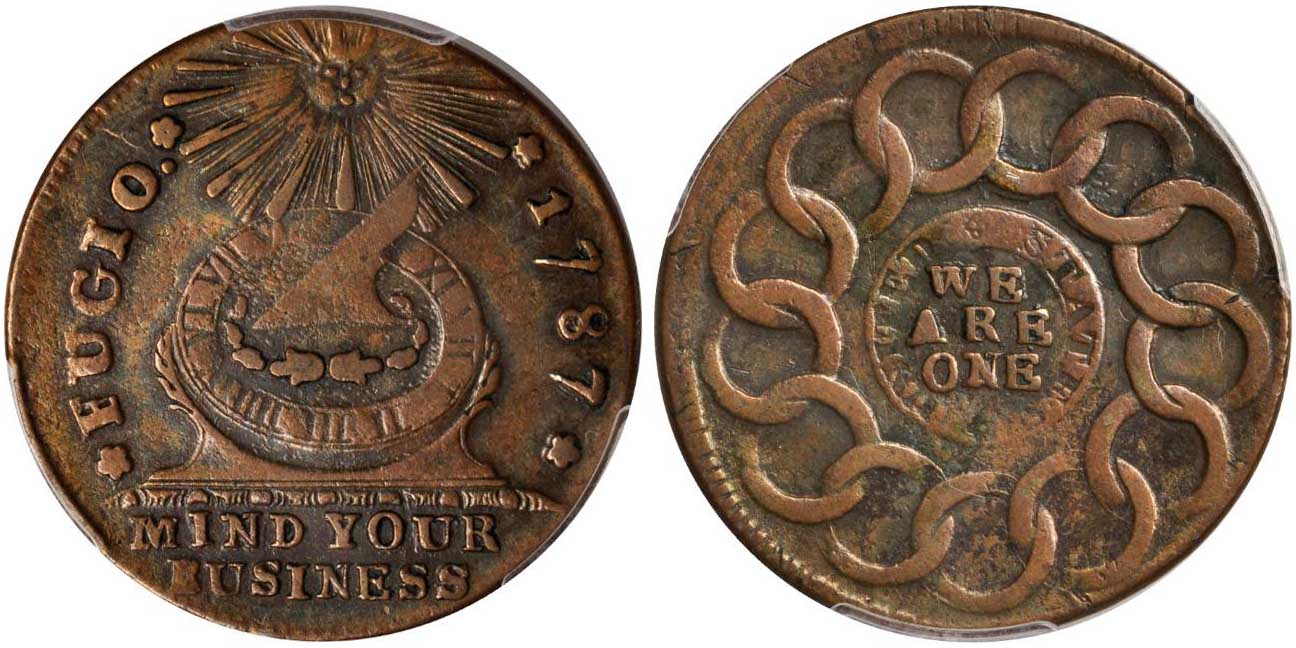
And lot #6778, a 1787 Fugio Newman 8-X with the die break through MIND YOUR BUSINESS in a PCGS MS64 BN holder which realized $6,462:
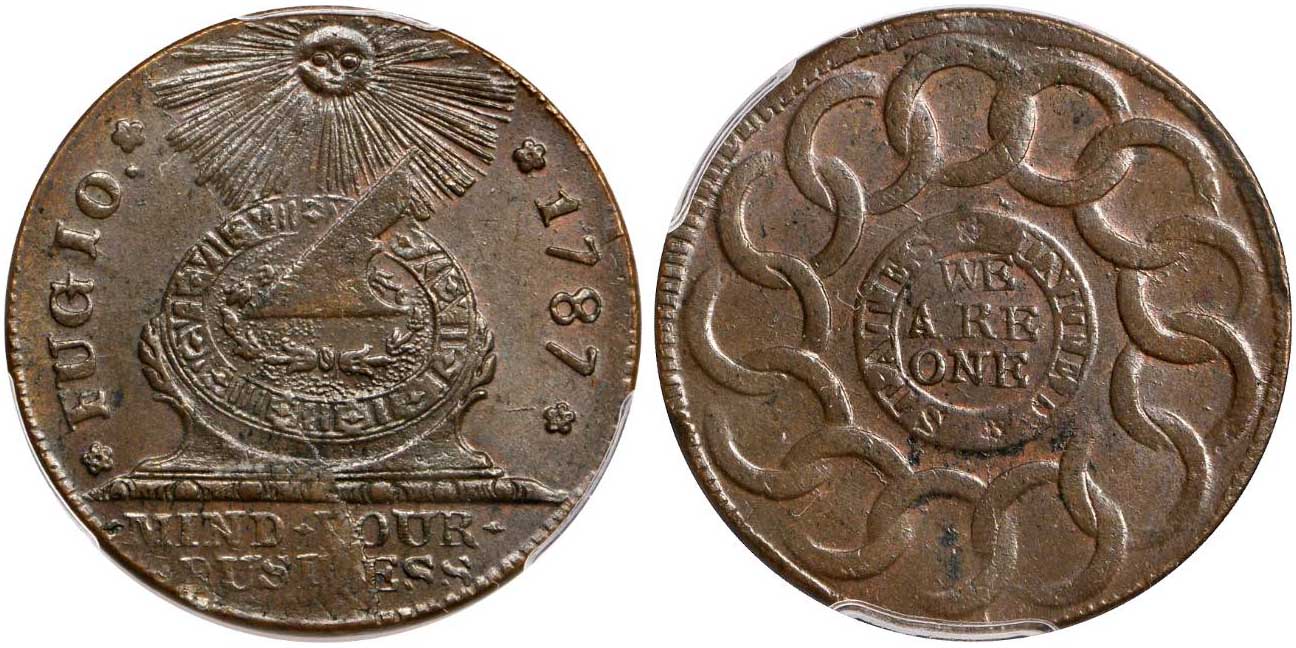
Results which I hope pleased the Retz family, who were all in attendance for the entire session and patienty waited literally all night for their father’s coins to cross the auction block.
After which the sale continued for another 160 lots or so, though more Fugios from other consignors, past the group lots and ending with the Contemporary Counterfeit 2 Reales consigned by some guy named Dave Wnuck and including coins that looked like lot #6911:
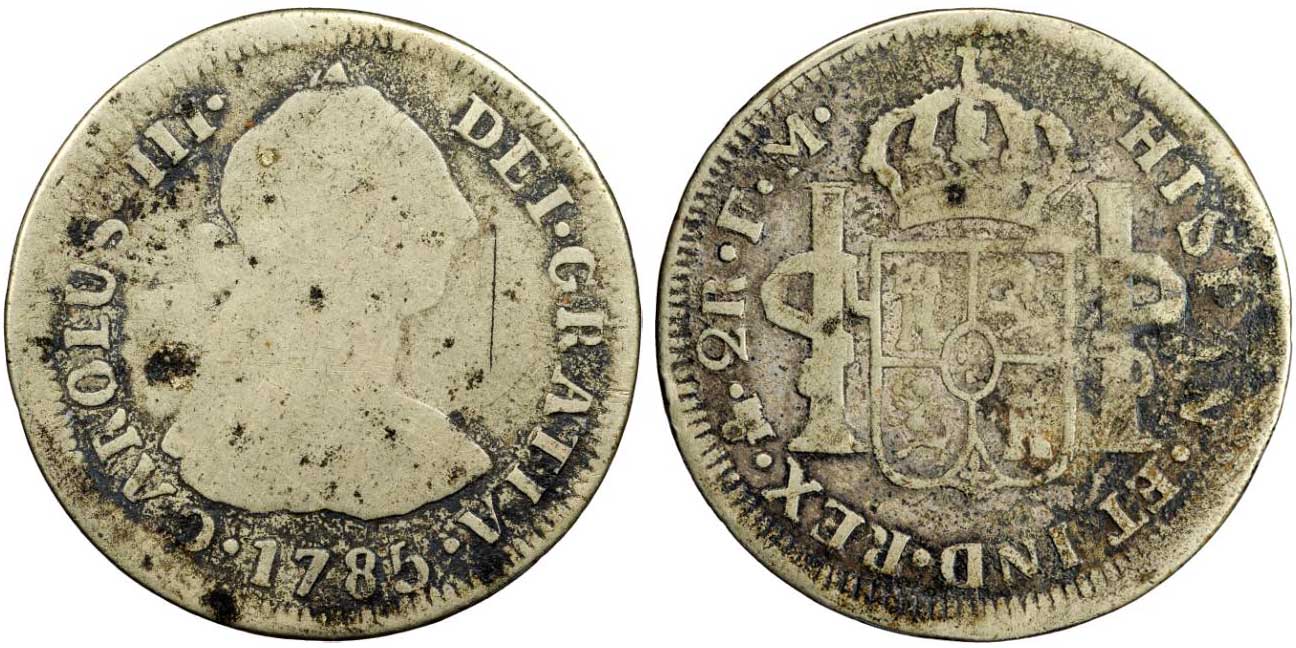
And while I hoped they would do well, by then I was exhausted and I don’t deal in these anyway, so I was long gone by the time the last lot hammered down at 3-something AM.
And what can I conclude about all of this? Several things, I think:
- Great rarities are always in demand.
- Coins with fabulous color and surfaces found many enthusiastic bidders.
- I have often said that in these auctions “Freshness Trumps Quality”, meaning that coins that have been off the market for a long time tend to do well at auction even if they aren’t that nice. But that was not always true here, with some of the fresh stuff that wasn’t nice selling for very modest prices.
- If you sell 900+ lots in one session, some things will fall through the cracks.
And how did I do? Your author probably bought more coins than pretty much anyone else over the span of the 8 and half hours I was in the room (which seems like an impossibly long time as I am typing this now). But I still regret the few that got away.
In any case, I will have to sign off here as I need to pack up, check out of the hotel and head off the convention center for what might be a very busy Saturday which I am confident I can handle if I drink enough coffee before I get there.
More later.
November 17th: Day 5
I think it’s important to point out that although I have already typed endlessly about how late I was at the auction Friday night and how little sleep I got, I was, of course, not the only person doing that. In fact, there were a number of other collectors and dealers who stayed longer than I did. Not to mention the Stack’s-Bowers team, who worked harder, longer than any of us bidders. And yet most of those people were back at the show first thing Saturday AM ready for action.
Including me, parked behind the CRO table on a day that could not have started much better, with the sale of a 6-figure coin within the first few minutes.
And while that would be the only XL coin sold on Saturday, business was excellent all day, with lots of federal and colonial sales of all sorts to collectors and dealers alike. I even experienced a most welcome ‘call back’, where a collector who had already left the show on Friday called me back to say he had decided to go ahead and buy an item he had seen in the case (in this instance that nifty Hawaiian denomination set). Not to mention two other potentially very big deals in the works.
I did some surprisingly good buying as well, including a few more things that walked up to the table, choice federal, and some colonials on the floor that I had seen earlier in the week, and liked, but which now seemed much more reasonably priced based on the wicked high auction results for similar items just 12 hours earlier.
Somewhere along the way I also picked up the first part of my auction winnings (or rather they were delivered to me, conveniently, at the CRO table), but I never had the time to even look at them and instead just locked them in the back case.
And then I looked down and realized it was already 1:30, and I had about an hour to pack up everything, chase down a few checks, pay for 3 coins, turn in my Whitman contract for the next Baltimore show in March 2013, pick up a coin at grading and finalize one other pending deal.
So I raced around the room as fast as I could, got back to the table and was packing up like crazy as a steady stream of collectors and dealers kept stopping by to look at the coins I had not boxed up yet, or show me new coins to buy. Until I just had to say no mas, finish packing and take off for the airport at a time when it was obvious that there was still plenty more business to be done at this show. Unfortunately, I couldn’t stay, but if I had known it was going to be this good I’d have made other arrangements.
Oh well, it’s probably for the best, since I was absolutely running on empty by that time after a wild week and it was all I could do not to fall asleep in the airport security line. I managed to stay awake though, and get home just in time to write this blog and to reflect on what was one of the best, busiest, most entertaining and most successful shows I’ve ever attended.
And now, if you will excuse me, I am going to bed.
JA

